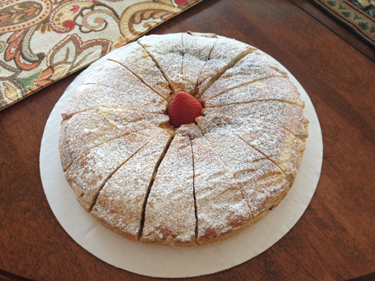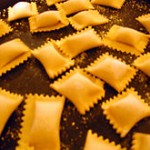Despite being the totally unaccomplished baker that I am I foolishly accepted an invitation from the Order of the Sons of Italy in America, Ocean City Lodge, to prepare a seasonal dessert dish for a recent meeting of members. Since the OC Lodge has around 150 members, roughly 100 of whom show up at every meeting, other members were drafted to perform similar service for the occasion, each preparing something different.
Since it was Easter season I chose the one item that probably sits quietly on every Italian family table on Easter Sunday, waiting for the lasagne and roast pork or lamb to be consumed in their entirety. Crostata di Ricotta! Ricotta cheesecake.
Some idle background (which of course you should skip):
The word “crostata” is Italian for anything, sweet or savory, wrapped in a crust or pie dough, one version of which is commonly known in Italy as “pasta frolla.” You can make “pasta frolla” from scratch or you can make the pre-mixed boxed Pillsbury stuff, or you can make Betty Crocker’s Cookbook classic apple pie dough recipe and most likely no one will know the difference. I decided to take the high road.
In this instance I followed a recipe published by Chef Carlo Middione in his excellent volume The Food of Southern Italy (William Morrow & Co., New York, 1987, p 271). How many remember Carlo as the host of the now defunct TV series “Carlo Cooks“? It was one of those rare shows that provided straight no-nonsense informative content minus the family walk-ons (Lidia), the non-stop chatter (Rachel, Sunny), annoying slapstick (Alton Brown), or the mindless video clips of the local butcher or farmers market (Ina Garten). Carlo where are you buddy??
In any case once you get a handle on the “pasta frolla” you are on your way to a classic treat that actually does not need a holiday or particular season as an excuse to serve.
To make life interesting I set out below Carlo’s recipe for pasta frolla and in parentheses a popular recipe from an Italian website. Slightly different as you can see.
Crostata di Ricotta
For the pie crust “pasta frolla:”
- 2 1/2 cups all purpose flour (same)
- 1/2 cup granulated sugar (sifted confectioners sugar)
- 1/2 tsp. salt (no salt)
- 1/2 cup “sweet” butter cut in small cubes (unsalted butter)
- grated rind from one lemon (same)
- 4 or 5 tbsp. ice water (four egg yolks)
Process the flour, sugar, salt, lemon rind and butter until the ingredients just begin to look like coarse sand. Slowly add the water (or the egg yolks) until all ingredients come together in a rough ball. Turn onto a floured pastry board and knead quickly for two or three minutes or until everything holds together. Flatten the dough, wrap tightly with plastic wrap and refrigerate for 30 minutes.
For the ricotta filling:
- 1/2 cup golden raisins (or dark if you want to avoid a special trip to the market)
- 3 or 4 tbsp. dark rum (or light if you already drank all the dark)
- 1 1/2 lbs. ricotta (the Sorrento/Galbani brand is the only one to use)
- 1/2 cup chopped blanched almonds (or non-blanched to avoid yet another trip)
- 2 large eggs
- zest of 1 lemon and 1/2 orange
- 1/2 cup sugar
- 1 tsp. vanilla
- 3 tbsp. all purpose flour
Preparation:
Have ready a 9 or 10-inch springform pan and preheat oven to 375 degrees.
Soak the raisins in the rum for 20 minutes. Mix all the other ingredients in a bowl. Divide dough in half and roll out one half into a 16 inch circle, or one large enough to line the bottom and side of the baking pan, allowing a one inch border hanging over the edge.
Pour the filling into the pan to one inch below the rim and proceed with the top layer of dough. Now here is the caveat: Carlo’s recipe, and many the italian versions, call for making the fancy checkerboard interlaced strips for the top layer. I instead call for avoiding that like the plague, thus saving over an hour of agonizing labor with a crimping cutter. As a result more “pasta frolla” dough might be necessary for a wall-to-wall top crust, I took the precaution of making up a dough recipe with increased ingredient quantities all around. Three cups flour instead of 2 1/2, etc.
I omitted the candied orange peel called for in Carlo’s recipe. It seemed superfluous given the inclusion of orange and lemon zest. But it is traditional.
OK, brush the pastry top with egg wash and sprinkle with sugar, any kind, then bake for 45 minutes to an hour or until crust has a gorgeous golden brown color. If it doesn’t look gorgeous toss the whole thing and start over.
 Being paranoid I allowed the cake to cool down to room temperature, then tapped it all around with the back of a spoon before attempting to release from the springform. Mine came out just fine so I rewarded myself with a double Margarita since the rum bottle was still hanging around on the kitchen table.
Being paranoid I allowed the cake to cool down to room temperature, then tapped it all around with the back of a spoon before attempting to release from the springform. Mine came out just fine so I rewarded myself with a double Margarita since the rum bottle was still hanging around on the kitchen table.



 One day recently I nearly lapsed into a catatonic state watching the Food Network’s “Pioneer Woman” whip up a hearty batch of steak n’ eggs for all the buckaroos on the ranch. Before passing out I had a straight off the wall idea flash before me. I imagined that I would become the world’s leading expert on the connections between French and Italian cuisine.
One day recently I nearly lapsed into a catatonic state watching the Food Network’s “Pioneer Woman” whip up a hearty batch of steak n’ eggs for all the buckaroos on the ranch. Before passing out I had a straight off the wall idea flash before me. I imagined that I would become the world’s leading expert on the connections between French and Italian cuisine. Being paranoid I allowed the cake to cool down to room temperature, then tapped it all around with the back of a spoon before attempting to release from the springform. Mine came out just fine so I rewarded myself with a double Margarita since the rum bottle was still hanging around on the kitchen table.
Being paranoid I allowed the cake to cool down to room temperature, then tapped it all around with the back of a spoon before attempting to release from the springform. Mine came out just fine so I rewarded myself with a double Margarita since the rum bottle was still hanging around on the kitchen table. Probably the prize for the most unlikely title for a popular main dish should be awarded to the Romans. Some decades ago they concocted a veal cutlet creation using prosciutto ham and a leaf or two of sage as flavor accents. They gave it the most confounding label that would have the diner believe that the serving does not need a knife and fork because it simply “jumps in your mouth.” Saltimbocca alla Romana – the word “saltimbocca” being a fusion of the phrase “saltare in bocca.”
Probably the prize for the most unlikely title for a popular main dish should be awarded to the Romans. Some decades ago they concocted a veal cutlet creation using prosciutto ham and a leaf or two of sage as flavor accents. They gave it the most confounding label that would have the diner believe that the serving does not need a knife and fork because it simply “jumps in your mouth.” Saltimbocca alla Romana – the word “saltimbocca” being a fusion of the phrase “saltare in bocca.”